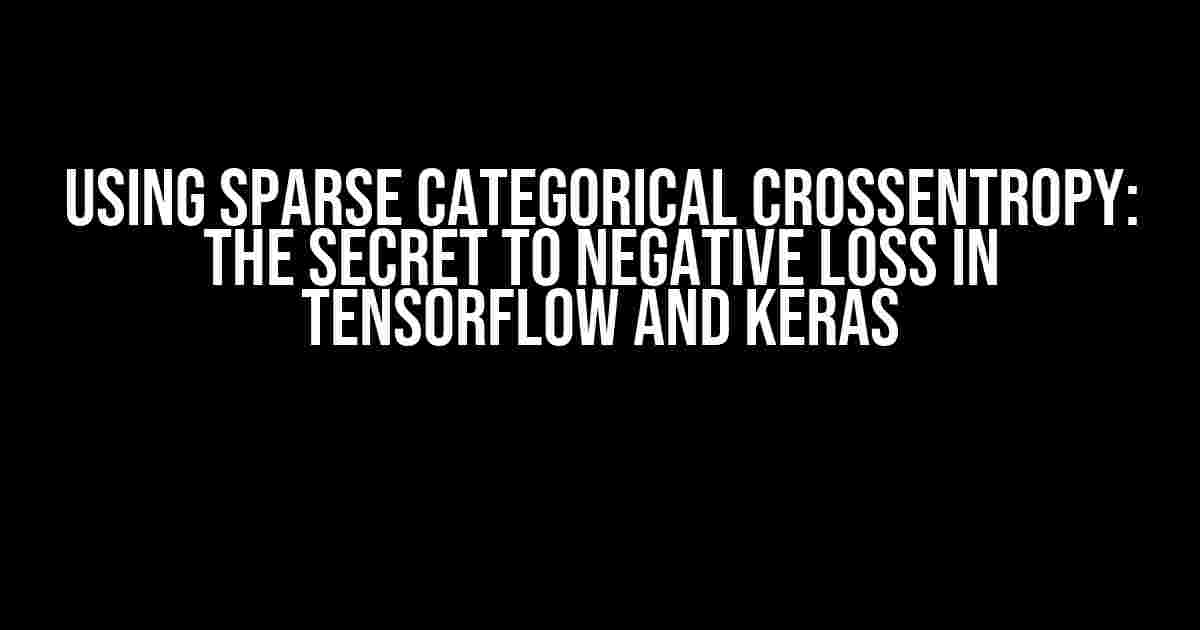Have you ever wondered how to optimize your neural network’s performance by manipulating the loss function? Well, wonder no more! In this article, we’ll dive into the world of sparse categorical cross-entropy and explore how it can lead to negative loss in TensorFlow and Keras.
What is Sparse Categorical Cross-Entropy?
Sparse categorical cross-entropy is a type of loss function used in machine learning, particularly in classification problems. It’s an extension of the traditional categorical cross-entropy loss function, designed to handle sparse labels.
from tensorflow.keras.losses import SparseCategoricalCrossentropy
loss_fn = SparseCategoricalCrossentropy(from_logits=True)In the above code snippet, we import the SparseCategoricalCrossentropy class from the TensorFlow Keras losses module and create an instance of it. The from_logits=True parameter indicates that the model’s output is not normalized using the softmax activation function.
How Does Sparse Categorical Cross-Entropy Work?
Sparse categorical cross-entropy calculates the loss between the predicted probabilities and the true labels. Unlike categorical cross-entropy, which assumes that the labels are one-hot encoded, sparse categorical cross-entropy works with sparse labels.
Let’s break it down step by step:
-
The model predicts a probability distribution over all classes.
-
The sparse categorical cross-entropy loss function calculates the cross-entropy between the predicted probabilities and the true sparse labels.
-
The loss is calculated as the average cross-entropy over all samples in the batch.
y_pred = model(x)
loss = tf.reduce_mean(tf.nn.sparse_softmax_cross_entropy_with_logits(labels=y_true, logits=y_pred))In the above code snippet, we calculate the sparse categorical cross-entropy loss using the tf.nn.sparse_softmax_cross_entropy_with_logits function.
Why Does Sparse Categorical Cross-Entropy Lead to Negative Loss?
Now, you might be wondering why sparse categorical cross-entropy can lead to negative loss. The reason lies in the way the loss function is calculated.
When the model is extremely confident in its predictions and the predicted probabilities are very close to the true labels, the cross-entropy loss can become negative. This is because the logarithmic term in the cross-entropy formula can become negative when the predicted probability is very close to 1.
loss = -tf.reduce_sum(y_true * tf.math.log(y_pred))In the above code snippet, we see the logarithmic term in the cross-entropy formula. When the predicted probability y_pred is very close to 1, the logarithmic term can become negative, resulting in a negative loss.
How to Use Sparse Categorical Cross-Entropy in TensorFlow and Keras
Now that we’ve understood the concept of sparse categorical cross-entropy and why it can lead to negative loss, let’s see how to use it in TensorFlow and Keras.
TensorFlow Example
import tensorflow as tf
# Define the model
model = tf.keras.models.Sequential([
tf.keras.layers.Dense(64, activation='relu'),
tf.keras.layers.Dense(10)
])
# Compile the model with sparse categorical cross-entropy loss
model.compile(optimizer='adam',
loss=tf.keras.losses.SparseCategoricalCrossentropy(from_logits=True),
metrics=['accuracy'])In the above code snippet, we define a simple neural network using the Sequential API and compile it with the sparse categorical cross-entropy loss function.
Keras Example
from keras.models import Sequential
from keras.layers import Dense
from keras.losses import SparseCategoricalCrossentropy
# Define the model
model = Sequential()
model.add(Dense(64, activation='relu'))
model.add(Dense(10))
# Compile the model with sparse categorical cross-entropy loss
model.compile(optimizer='adam',
loss=SparseCategoricalCrossentropy(from_logits=True),
metrics=['accuracy'])In the above code snippet, we define a simple neural network using the Sequential API and compile it with the sparse categorical cross-entropy loss function.
Advantages of Using Sparse Categorical Cross-Entropy
Using sparse categorical cross-entropy has several advantages:
-
It’s more efficient than one-hot encoded labels, especially when dealing with large numbers of classes.
-
It’s more accurate than categorical cross-entropy, especially when the true labels are sparse.
-
It’s more interpretable than categorical cross-entropy, as it provides a direct measure of the model’s confidence in its predictions.
Conclusion
In conclusion, sparse categorical cross-entropy is a powerful tool in the machine learning practitioner’s toolkit. By understanding how it works and how to use it in TensorFlow and Keras, we can optimize our neural networks’ performance and achieve better results.
Remember, the key to success lies in understanding the intricacies of the loss function and how it interacts with the model’s architecture. With sparse categorical cross-entropy, you can unlock new levels of performance and accuracy in your classification models.
FAQs
Here are some frequently asked questions about sparse categorical cross-entropy:
| Question | Answer |
|---|---|
| What is the difference between sparse categorical cross-entropy and categorical cross-entropy? | Sparse categorical cross-entropy is used for sparse labels, while categorical cross-entropy is used for one-hot encoded labels. |
| Why does sparse categorical cross-entropy lead to negative loss? | It leads to negative loss when the model is extremely confident in its predictions and the predicted probabilities are very close to the true labels. |
| How do I implement sparse categorical cross-entropy in TensorFlow and Keras? | You can implement it using the SparseCategoricalCrossentropy class in TensorFlow and Keras, and compile the model with the sparse categorical cross-entropy loss function. |
We hope this article has provided you with a comprehensive understanding of sparse categorical cross-entropy and its applications in machine learning. Happy coding!
Frequently Asked Question
Have you ever wondered why using sparse categorical cross-entropy in TensorFlow/Keras results in a negative loss? Well, you’re not alone! Let’s dive into the top 5 questions and answers to shed some light on this curious phenomenon.
Why does the loss become negative when using sparse categorical cross-entropy?
When using sparse categorical cross-entropy, the loss can become negative due to the way the categorical cross-entropy loss function is defined. The goal is to minimize the loss, but since it’s a log loss, the output can be negative. Think of it like a “negative” indication that your model is doing a fantastic job of predicting the correct class!
Is a negative loss a bad thing?
Nope! A negative loss is not inherently bad. In fact, it can be a good sign that your model is doing a great job of fitting the training data. However, if the loss is extremely negative (e.g., -Infinity), it might indicate numerical instability or exploding gradients, which can be a problem.
How does sparse categorical cross-entropy differ from categorical cross-entropy?
Sparse categorical cross-entropy is similar to categorical cross-entropy, but it’s used when the classes are mutually exclusive (e.g., when each sample belongs to only one class). The key difference is that sparse categorical cross-entropy assumes the targets are integer values (class indices), whereas categorical cross-entropy expects one-hot encoded targets.
Can I use sparse categorical cross-entropy for multi-class classification problems?
Yes, you can! Sparse categorical cross-entropy is suitable for multi-class classification problems where each sample belongs to only one class. However, if your problem involves multi-label classification (where each sample can belong to multiple classes), you’ll need to use a different loss function, such as binary cross-entropy.
How can I visualize the loss trend when using sparse categorical cross-entropy?
To visualize the loss trend, you can use a library like Matplotlib or Seaborn to plot the loss values against the training epoch. Since the loss can be negative, you might want to focus on the trend rather than the absolute value. A decreasing loss trend indicates that your model is improving, even if the values are negative!


